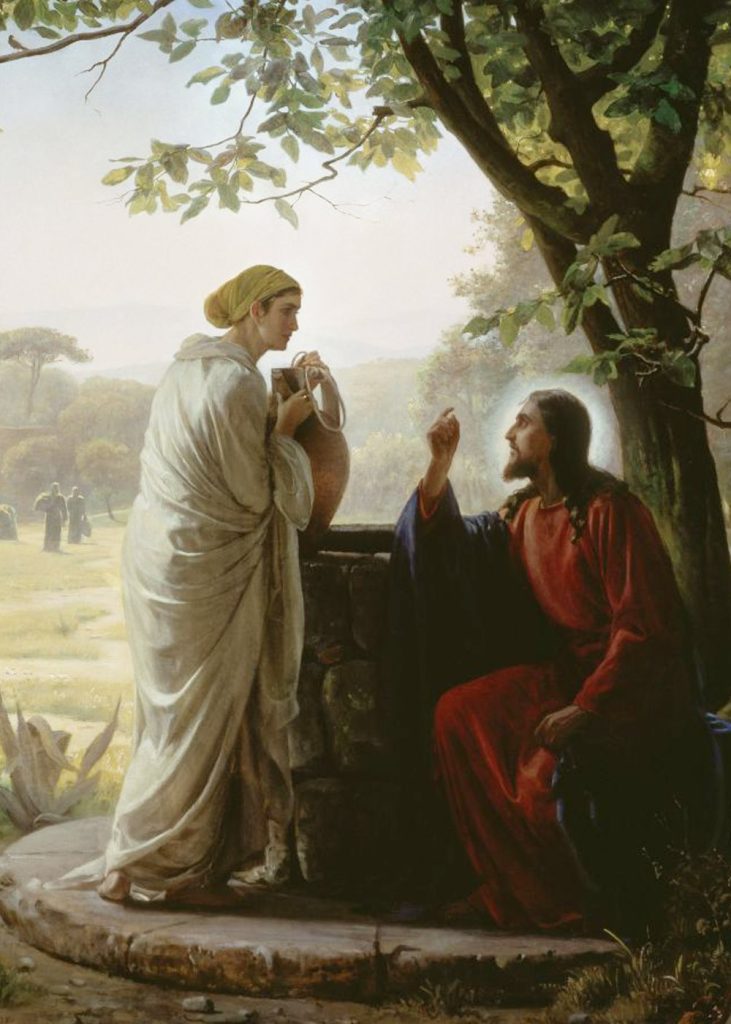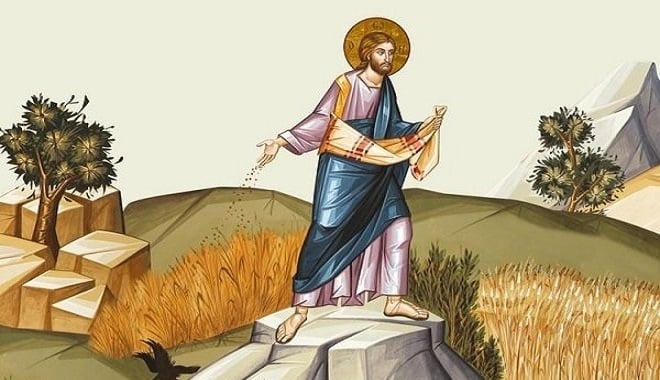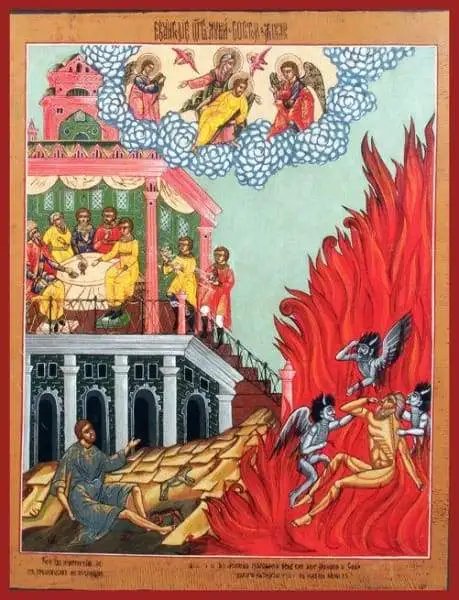
In the name of the Father, and of the Son, and of the Holy Spirit. Amen.
Christ is Risen! Truly He is Risen!
Beloved brethren in the Lord, today on this Fifth Sunday of Pascha, the Holy Church contemplates the wondrous meeting between our Saviour and the woman at Jacob’s well. This narrative, recorded in the fourth chapter of St John’s Gospel, offers us one of the most extensive dialogues of Christ preserved in Scripture.
The Evangelist tells us that our Lord, journeying from Judaea toward Galilee, “had to pass through Samaria.” This divine necessity was not merely geographical but providential, for a soul awaited salvation there. Coming to Sychar, near the parcel of ground Jacob gave to his son Joseph, Jesus rested at Jacob’s well while His disciples went to buy food.
It was about the sixth hour, midday, when a Samaritan woman came to draw water. What follows is a remarkable conversation that proceeds in ascending spiritual levels. Christ speaks first of “living water,” which the woman misunderstands as flowing spring water. He clarifies: “Whoever drinks of this water will thirst again, but whoever drinks of the water that I shall give him will never thirst… it will become in him a fountain of water springing up into everlasting life.”
When the woman requests this water, Christ redirects the conversation to her personal life, revealing His knowledge of her five previous husbands and present situation. Recognising Him as a prophet, she raises the contentious theological issue dividing Jews and Samaritans: the proper place of worship. Christ transcends this division with the revelation that true worshippers will worship “in spirit and truth,” for “God is Spirit.”
The dialogue reaches its climax when the woman speaks of the coming Messiah. Jesus declares with stunning directness: “I who speak to you am He.” This confession, one of the clearest self-revelations of Christ’s messianic identity in the Gospels, transforms the woman into an evangelist. Leaving her water jar, she returns to the city proclaiming, “Come, see a Man who told me all things that I ever did. Could this be the Christ?”
Her testimony was so compelling that many Samaritans came to believe, first because of her word, then because of Christ’s own teaching during the two days He stayed in their city. They declared: “Now we believe, not because of what you said, for we ourselves have heard Him and we know that this is indeed the Christ, the Saviour of the world.”
St Ephrem the Syrian observes that Christ, who gives drink to creation, asked for a drink to create an opportunity for dialogue: “The Lord of the sea asked for water, not because He needed it, but so that He might give the woman the water of life, and quench the thirst of her soul that burned with sins.”
St Gregory of Nyssa sees in the five husbands a reference to the limited perception of the five senses, which cannot lead to full spiritual understanding: “Having abandoned the guidance of reason, she had taken the five senses as her husbands, through which she had previously perceived only material things.”
According to Holy Tradition, this woman was named Photini, “the luminous one,” who later preached Christ fearlessly in Carthage and Rome. With her five sisters and two sons, she endured martyrdom under Emperor Nero, refusing to renounce her faith despite terrible tortures. The Church commemorates her feast on 26 February, honouring her as Equal-to-the-Apostles.
In the liturgical cycle, this Gospel reveals how Christ’s resurrection brings living water to all who thirst for truth. The hymns of the day proclaim: “The well-spring of the principle of life, Jesus our Saviour, came to the well of the patriarch Jacob, and sought water from a Samaritan woman that He might drink. And when she addressed Him and said that Jews have no dealings with Samaritans, the wise Creator diverted her by the sweetness of His words rather to seek the everlasting water, which, when she received it, she proclaimed to all, saying: Come and see the Knower of secrets, God Who is come in the flesh to save mankind.”
The historical context illuminates the radical nature of this encounter. The division between Jews and Samaritans stretched back centuries to the Assyrian conquest in 722 BC, when foreigners were settled in the Northern Kingdom, leading to mixed marriages and syncretistic religious practices. When the Jews returned from Babylonian exile, they rejected Samaritan offers to help rebuild the Temple. Subsequently, the Samaritans constructed their own temple on Mount Gerizim and recognised only the Pentateuch as Scripture.
By Jesus’ time, the hostility was so intense that Jews typically travelled the longer eastern route through the Jordan Valley to avoid Samaria entirely. The fact that Jesus “had to go through Samaria” signifies His divine mission to break down walls of separation. Jacob’s well itself had historical significance as a connection to the patriarchs, a physical location where the old and new covenants would intersect.
Archaeological excavations have confirmed the well’s existence in Nablus (ancient Shechem), where a church was built over it as early as the 4th century. Today, the Greek Orthodox Church of St Photini stands at this site, preserving this holy place where divine and human encounter transformed not just one soul but an entire community.
This Gospel narrative reveals deep theological truths central to our Orthodox faith. First, it manifests the mystery of the Incarnation. Christ exhibits His humanity in His weariness from travel and His thirst yet simultaneously reveals His divinity through His knowledge of the woman’s life and His offer of living water that leads to eternal life.
Second, it demonstrates the universal scope of salvation. The Samaritan woman, female, ethnically mixed, religiously heterodox, and morally compromised, represents those at the margins whom Christ came to save. As St Paul would later write, “There is neither Jew nor Greek, there is neither slave nor free, there is neither male nor female; for you are all one in Christ Jesus” (Galatians 3:28).
Third, Christ’s teaching about worship “in spirit and truth” establishes that authentic communion with God transcends physical locations and external rituals. As St John of Damascus explains: “Since God is immaterial and incorporeal and invisible, He cannot be worshipped in a material place. Since He is Spirit, He must be worshipped in spirit and truth.” This does not abolish liturgical worship but rather infuses it with inner meaning.
Fourth, the living water Christ offers signifies the grace of the Holy Spirit given in baptism and continually renewed in the sacramental life of the Church. As He later proclaimed at the Feast of Tabernacles, “If anyone thirsts, let him come to Me and drink. He who believes in Me, as the Scripture has said, out of his heart will flow rivers of living water” (John 7:37–38).
Fifth, this passage reveals the missionary character of the Church. The Samaritan woman, St Photini, becomes an evangelist, bringing her city to faith through her testimony. Her words “Come and see” echo the apostolic call that extends through every generation of believers.
Beloved in Christ, how does this Gospel speak to our lives today?
Like the Samaritan woman, we all come to the wells of this world seeking to quench our thirst, perhaps in relationships, achievements, possessions, or pleasures. Yet these temporal waters cannot satisfy our deepest longing, which is for communion with the living God. Only Christ can offer the water that becomes “a fountain springing up into everlasting life.”
The woman came at noon, avoiding others due to her reputation. Many of us similarly hide our wounds and failures, approaching God when we think no one is watching. Yet Christ awaits us precisely in these moments of vulnerability, knowing everything we have ever done, yet offering not condemnation but transformation.
Notice Christ’s method of spiritual guidance. He begins where the woman is, with her physical thirst and daily task, and gradually elevates her understanding toward divine realities. This is the pattern of divine pedagogy in our lives as well. God meets us in our ordinary circumstances and leads us, step by step, toward deeper spiritual perception.
The dialogue proceeds through stages that mirror our own spiritual journey: from misunderstanding, confusing living water with flowing spring water, to recognition of prophetic insight, “Sir, I perceive that You are a prophet,” to theological inquiry, the question about worship, and finally to messianic revelation, “I who speak to you am He.” Each of us traverses this path of growing illumination as we draw nearer to Christ.
When the woman encountered Christ, she left her water jar to tell others. How many of us, having met the Lord in prayer or sacrament, immediately return to our worldly concerns without sharing our experience? The water jar represents not only her errand but her previous way of life, left behind in the presence of living water.
Her evangelistic method is instructive: “Come and see a Man who told me all things that I ever did.” She does not present complex theology but simple testimony: this is what happened to me. In our increasingly secular society, such authentic witness may be more effective than abstract arguments.
Finally, observe that her testimony led others to Christ, but they ultimately believed because of their own encounter with Him: “Now we believe, not because of what you said, for we ourselves have heard Him.” Our role as witnesses is not to replace Christ but to lead others to their own experience of His presence, particularly in the Divine Liturgy and Holy Mysteries of the Church.
As we continue our paschal journey, let us approach Christ as did St Photini, with openness to His revelation, willingness to acknowledge our thirst, readiness to leave behind our water jars, and eagerness to share the living water with others. For as St Photini herself discovered, this water becomes not merely a well within us but a fountain springing up into eternal life.
Through the prayers of the Holy Equal-to-the-Apostles Martyr Photini, the Samaritan Woman, and of all Your saints, O Christ our God, have mercy on us and save us. Amen.
Christ is Risen! Truly He is Risen!
Copyright © 2025 The Rev. Adrian Augustus. The Russian Orthodox Church of the Archangel Michael, Blacktown, NSW


